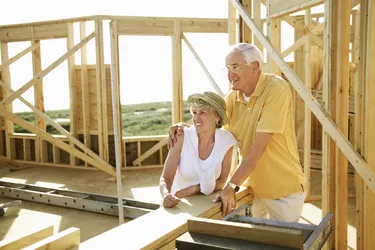
You can build a house for $150,000, but it requires planning, knowledge and discipline. Although many factors affect the cost of residential construction, its location, size and design are most important. It's also important to read about the building and building contract process before you begin.
Average U.S. Building Costs
Video of the Day
According to the 2014 survey conducted by the National Association of Home Builders, the average cost of a new U.S. house in 2013 was $246,453, which included building lot, financing, contractor fees, fixtures and appliances. This, however, is for a 2,607 square-foot house on a 14,359 square-foot lot. Until late in the 20th century, houses were much smaller. After World War II and the Korean War, livable houses averaging less than 1,000 square feet were built to accommodate returning veterans and their families. In urban areas, lots often average less than 5,000 square feet. Since square footage of both lot and building directly affect cost, reducing the projected size of both is a critical strategy when keeping to a $150,000 budget.
Video of the Day
Location, Location, Location
Where you build your house is another important consideration. New construction in California coastal areas, for example, is extremely expensive, averaging more than $500,000 according to a 2014 Los Angeles Times survey. Generally speaking, you'll encounter higher building costs in desirable coastal, recreation or retirement areas, such as Marin County, California; Aspen, Colorado; and Miami, as well as flourishing urban centers, such as San Francisco and Silicon Valley, New York, Seattle, and Los Angeles. States with relatively strong unions, such as California, Washington and Oregon, also have higher costs. Lower costs are more common in right-to-work states, unfashionable living inland areas with declining populations and areas with a surplus of immigrant labor.
Design and Preparation Considerations
Many houses are unnecessarily expensive because cost factors were not emphasized early. An architect's housing design generally costs about 10 percent of the building cost. A design by a recommended building designer, however, may cost $1,500 or less. If the designer understands that cost containment is paramount, she will probably come up with a cost-efficient solution. Otherwise, you may get a beautiful design you can't afford to build. Be sure to set square footage maximums early in the process -- this is key to containing costs. A 650 square-foot house is very livable for two to three persons.
Selecting a Contractor and Agreeing on the Contract
Persons building their first house may believe that whoever bids lowest is the right choice for a contractor. This is seldom true. A common problem in residential building is the low bidder who does terrible work or walks away from the job with your money. Get many references and check them carefully. Educate yourself about building contracts. Agree beforehand in your contract on how design-change costs will be calculated. Periodically check suppliers to determine they've been paid. A cost-plus contract can be very cost-effective, but requires a very equitable contractor. Be sure you understand what the cost basis is. A 15 percent contractor's fee for labor is reasonable if the labor costs are net. If the contractor has included generous overhead charges, including insurance and office costs in addition to the agreed upon profit percentage, a laborer paid $15 per hour can cost you three or four times as much.